
..........................................................................................................................................................................................................
am i doing it wrong?

as i'm sure i've mentioned before, i am something of a stranger at my local medical practice due, in the most part, to rather excellent continuing health. granted, there is the odd niggling pain here and there, mostly back and shoulder related, but when you reach my wizened old-age, it would be naive to expect the honed physique to be 100%. and, in mitigation, i know almost precisely what causes those niggles, yet rarely succeed in suitably updating my posture to alleviate the twinges.
as if to underline the ever-widening gap between me and the doctor i never visit, when i last received a bicycle helmet for review that featured the opportunity to include medical details on an associated website, i found myself ignorant of my blood group. on contacting the doctor, it transpired that he too was just as ignorant. that's perhaps nothing to be proud of from the point of view of either party, but such is life.
it has thus suited my purposes to lay the blame for such excellent health at the door of regular cycling. no matter the weather, no matter any trials and tribulations associated with work, i can pretty much guarantee that i will take to the saddle each and every weekend, with the occasional mid-week ride thrown in for good measure. and very much (i'm sure), to the annoyance of everyone within earshot, whenever health problems become the subject of conversation, there will be an irritating me stood in the corner, pointing out that cycling could have either prevented it, or be seen as the ultimate cure. oddly enough, tacit agreement usually follows.
however, aside from the health and mental benefits i believe i am accruing during each and every bicycle ride, i figure the exercise not only does me good, but keeps me fit as i enter my dotage. what i have never considered, is having to exercise to keep me fit and supple enough to continue cycling into the future. my model for this philosophy is the mighty dave t. he is edging closer to four-score years and still rides his bicycle as if he were a teenager. the nearest i believe he gets to extra-curricular exercise, is watching the cricket. so i have to ask why i would behave any differently?
my query was recently underlined by the news of 'essentrics' launch in the uk. 'essentrics' is the brainchild of 'one of North America's greatest healthy aging educators, Miranda Esmonde-White', who has presented new workouts for cyclists. according to the launch information, 'Conditioning for cycling is a fresh, easy way to activate and release muscles pre and post-cycling.' what i then have to ask myself is whether this is a) necessary and b) helpful in a situation where we're trying to convince all and sundry that cycling is perhaps the ideal transport solution, post-lockdown. it seems a tad counter-productive to assure the apprentic cycling fraternity that there's no earthly need to wear lycra or other special clothing simply to ride a bicycle to the shops, to school or to work. but then to present them with a daily workout to "rebalance the complete body by ensuring that all muscles, joints and bones are strengthened, that fscia and connective tissue is hydrated and lubricated, and that cells are activated and remain healthy."
particularly if it has sort of been implied that cycling itself will achieve the very same.
i realise that the above demonstrates an unhealthy level of cynicism, but i'm inclined to be just a wee bit disparaging of any press release that contains the phrase, 'weekend-warrior'. however, in the assumption that my reader does not share my scoffing nature, even following a press release headed 'Cycling as a New fitness Autumn Trend', the fitness programme under discussion, is apparently suitable for all levels of cyclist and available on smartphones, tablets, computers or tv. top trainer, meg feeney maintains that "working out before cycling will help to prepare the body by dynamically stretching and strengthening muscles..."
so, before you get in the shower each morning, prior to making breakfast for the kids and seeing them safely out the door, when you thought it merely a case of extricating the bicycle from the shed on which to cycle to work, you should check your smartphone for the pre-travel exercise workout. it seems quite ironic that 'essentrics' should quote john f. kennedy's statement that "nothing compares to the simple pleasure of riding a bike." , immediately following 300 words where they attempt to make it more complex.
monday 14 september 2020
 ..........................................................................................................................................................................................................
..........................................................................................................................................................................................................dexshell lightweight overshoes
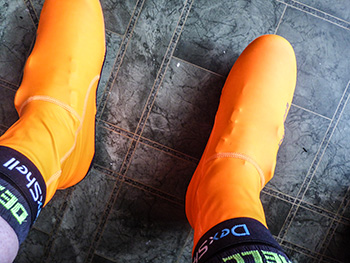
despite a lengthy period of lockdown, this past summer hasn't been too troublesome out here in the sticks. there's a distinct difference between riding in manland conurbations and doing likewise in rural islands such as islay. while friends in scottish cities have been on the receiving end of verbal abuse even while cycling alone, i've received nothing but thumbs up, flashed headlights and waves from local passing motorists, even when riding a darned sight farther than five miles from the croft.
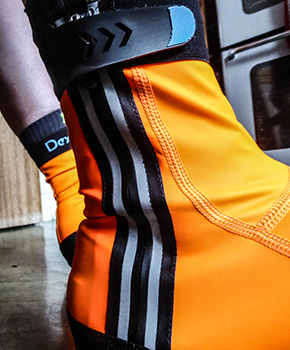
the warm, sunny weather, mostly unheard of round these parts, even had yours truly break out the extreme lightweight jersey that i thought i'd never have need of, and a faster draining of the sun cream bottle than has ever previously been the case. the trouble with weather such as that, is that, either you get used to it, or spend most of your riding time being a pessimist and wondering how soon it's all going to come to a sudden halt. the latter, sort of happened just over a week past, oddly enough, coinciding with receipt of a pair of bright orange dexshell lightweight overshoes.
i say 'oddly', because experience has taught me that the arrival of any sort of waterproof garmentage usually entails a lengthy period of fine weather, often meaning an e-mail to the distributor apologising for the time it has taken to review their product. however, i may have counted my chickens just a tad too early.
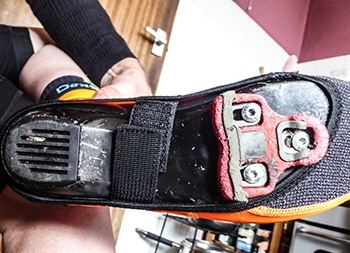
the first ride that necessitated orange feet, dawned wet and windy, offering the ideal excuse to head out with shoes hidden 'neath dexshell's lightweight waterproofing. disappointingly, from that point of view at least, the rain was off by the time i'd ridden little more than a kilometre. of course, there's more than just a rainy day that would necessitate a pair of overshoes; presuming the rain to have been prolonged and heavy enough, surface water can often be just as much a problem as can persistent precipitation.
a smattering of rain punctuated said ride, but honestly, if i'd known then what i knew by my return, i'd probably not have bothered. now, under normal circumstances, riding in dry weather with waterproof overshoes would have been considered an embarrassing situation. however, such is their incredible lightness of being, that they have the look of a pair of (very) bright oversocks which, obviously enough, a stylish yet honed athlete such as myself, would be inclined to wear in the normal run of a day's velocipedinal action.
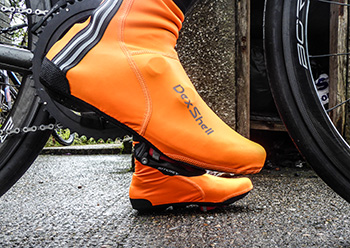
there have been subsequent days where the weather outlook demanded that overshoes were required, even if only for the potential of rain later in the day. in truth, most of those were realised, but never quite to the extent that it was necessary to construct a large, clinker-buit boat capable of carrying two of every species on earth. but the overshoes were tested in other, more unexpected ways.
dexhsell have eschewed two of the commonalities associated with waterproof overshoes. firstly, the sole is completely non-existent, retention managed by a velcro strip midway along the foot. this means that, when walking becomes a necessity, there is nothing to wear out. and there seems to be no real problem with water ingress from below. this particular feature came into its own, when i punctured and had need of walking a short distance to find a modicum of shelter to carry out tube replacement. the dexshells looked none the worse for wear on arriving home.
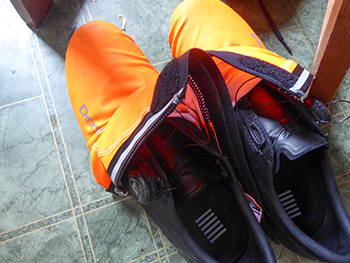
secondly, the majority of overshoes feature the zip at the rear, while dexshell have installed theirs offset on the outer edge of the heel, topped by a velcro strap. i wouldn't have minded an extra centimetre or two in height, for several of my socks are longer than the overshoes, but overall this doesn't seem to be have too much of a negative effect. placing the zip at the side, does seem to make it a smidgeon harder to close, particularly in the light of an inner storm flap which frequently caught on the zip at the bottom if i wasn't paying attention.
but all considered, these are really, really good. their lightweight construction means that, if the weather unexpectedly clears, and you're not as stylish as me, you can scrunch them up and stuff them in a rear pocket. they made an excellent job of keep my footwear dry, and did a marvellous job when we'd to pedal through a couple of instances of localised flooding on the sunday morning ride. they might not be ideal when the temperature drops below zero, but nobody said they were supposed to.
brilliant in both senses of that word.
dexshell's lightweight overshoe is available in sizes medium and large, in either bright orange (handy if you have to ditch in the sea; the helicopters will find you first) or lime green. price is a very welcome £35
dexshell lightwieght overshoes
monday 14 september 2020
 ..........................................................................................................................................................................................................
..........................................................................................................................................................................................................precise intolerance

somewhat inadvertently, one evening last week, i watched a documentary about the boeing 747. this followed the evolution of the world's largest passenger aircraft from the drawing board to the most recent version, the 800 series. there was, however, towards the end of the programme, a tinge of irony. made in 2014, the documentary would obviously have no idea of the disruption caused to the airline industry in 2020, therefore comments such as "i think there will always be a 747 well into the future." and "i believe this is an aircraft that will outlive most of us alive today", must surely cause their originators at least a smidgeon of embarrassment?
the irony preceded the broadcasting of the documentary by only a couple of days, when my daily newspaper printed images of row upon row of boeing 747s laid up on airport grounds as they wait their future dismantling. with covid-19 having caused huge reductions in airline passengers, the world's airways have grounded all their jumbo jets, soon to have them struck from the fleets.
and if the watching of this particular documentary was accidental, the following programme came entirely out of left field. related to the 747 film, this subsequent slice of television was entitled 'how to build a rolls-royce trent engine'. it transpires that this was not one of those endless magazine editions that brings a small part of a trent high-bypass aircraft engine each week to be built piece by piece, but a stage by stage presentation from inside rolls-royce, depicting how one of these high precision and incredibly high priced means of jet propulsion is constructed.
like many aircraft-related items, a trent jet engine is assembled from sections built by different departments, and put together vertically. the latter process allows one part to marry perfectly with the adjacent bit while closely observed by engineers as one is gently lowered onto the other. due to the need to avoid any minor scrapes and dings during this process, it was described as imperative that one did not touch the other until the two were finally conjoined. precision engineers then bolted the two together using torque wrenches that made anything in a bike shop look like neanderthal clubs.
and once the whole enchilada was complete, an enthusiastic fellow with a tiny camera on the end of a long fibre cable, inspected every internal part of the engine before wrapping it up and sending it off to the customer. of course, there was irony there too, as the company has subsequently experienced expensive problems with two editions of the trent engine.
unlike the bicycle industry, the precision employed in the construction of a powerful jet engine is measured in tenths of millimetres, or smaller. thankfully, such precision is less of a concern in relation to bicycle componentry, not only because a bottom bracket failure is unlikely to result in a rapid descent over thousands of feet, ending in total destruction at the end, but also because it would likely magnify the cost tenfold. that said, there are occasions when a smidgeon more precision would be welcomed with open thumbs.
saturday afternoon, pretty much at the furthest point from home, i rode over something very sharp which blew out my rear tyre leaving two substantial splits in the carcass, through which the replacement tube was likely to exit explosively when inflated. to prevent this happening and enable me to ride home, i placed a length of the damaged tube inside the tyre to block the cuts, before inserting the new tube and carefully inflating the tube.
unfortunately, the entire process was unnecessarily lengthened by the almost impossible task of seating the last few centimetres of tyre sidewall over the lip of the rim. that took the better part of twenty minutes, almost destroying the tyre lever and doing little for the health of my thumbs. you (and i), however, will be pleased to hear that it survived the intervening 25km of islay's roads, and i arrived home late, but safely.
of course, as we all know, that was scarcely the end of the drama, as fitting a replacement tyre provided even more grief for those suffering thumbs. what i want to know is why?
last weekend i replaced a 27.5" mountain bike tyre, which was easily accomplished without any thought of resort to a pink tyre lever. yet, though my campagnolo bora wheels are the industry standard 700c diameter, and the tyre (700 x 28c) reputedly adheres to the same standard, why is any attempt to fit one to t'other fraught with grunting, swearing and very sore thumbs? i tried two tyres from different manufacturers, yet one was every bit as strenuous as the other. i'd finally to resort to the old tubular trick of removing the tyre, standing on it and pulling up on the other end to try and stretch it (which, oddly, seemed to work).
i realise that a rolls-royce trent engine is several levels of expense above the humble road tyre, but is it outwith the bounds of possibility to manufacture a tyre that will fit a wheel without causing thumb disability? i also know that the tyre requires to be at least modestly 'tight' on the rim to prevent it rolling off or allowing the inner tube to escape when inflated, but there's 'tight' and there's 'tight'.
my thumbs and i look forward to the day when there exists an aerospace derived road tyre, preferably not tubeless.
sunday 13 september 2020
 ..........................................................................................................................................................................................................
..........................................................................................................................................................................................................hedge funds

a friend of mine always said that 'to assume, makes an ass out of you and me', yet here i am invoking the rule of assumption nonetheless.
i am assuming that, when motorway and road planners are planning their roads, or planning amendments to existing roads, they base everything on a series of numbers. those numbers, i assume, inform them as to how many vehicles are making use of existing roadways, which, when matched with the maximum planned for, will dictate whether adjustments require to be made. and if a road was originally built to cope with 1,000 cars per hour and that number is being exceeded, there may be good cause (in planners' eyes at least), for building another road, or another lane.
the essential bit missing, i would have thought, is any form of consultation with the people that actually use the hypothetical roads under discussion. maybe many drivers would prefer alternative solutions, rather than altering a road to allow more traffic to use it. the same could equally be said for the pedestrian fraternity.
at present, construction is halfway completed on a mixed-use path between the villages of port charlotte and bruichladdich, an innovation that has gained a great deal of local approbation. yet in all the years i have ridden between those two villages, i could count on the fingers of one hand, the number of folks i've seen walking at the roadside. but then, it could be me that's wrong, and the reputedly numerous walkers simply do so at times other than those in which i've been riding.
the path, however, as mentioned, will be mixed-use, receiving a tarmac coating to allow for cyclists to get in the way of all those walkers. i have no doubt, when completed, the path will generate foot and cycle traffic that will justify its existence, but i'm not entirely sure who was asked about its need in the first place. i do recall being invited to submit a letter of support on behalf of the island's cyclists, which, social responsibility dictated, i was happy to do. but nowhere did i indicate that we'd actually use it at anytime.
all this came to my attention yesterday on my fortnightly paper delivery run to debbie's. the prevailing winds on islay tend to be from the south-west, meaning that on turning left at bridgend to head to bruichladdich, what may have been a reasonably inert cross tailwind, often morphs into a raging headwind of the galeforce variety. there's a modicum of shelter until reaching crosshouses, but that disappears entirely at the foot of the hill at blackrock, approaching uiskentuie strand.
yesterday's winds were very definitely of the south-westerly galeforce variety.
the strand is at the head of loch indaal, only 3km in length and curves gently towards the south, ending at foreland road end. loch indaal is an open sea loch, but a hop, skip and a jump from the north atlantic, along which the strand offers no shelter whatsoever. in winter months i have frequently opted for the 'cross bike because, slower though it may be, its chunky tyres allow me to ride on the grass along the shore; if i get blown over (and it's happened more than once), i have a soft landing.
my compatriot and i, slogging along this wind-strewn road on friday afternoon, were of a mind that a modestly-sized hedgerow along the left side of the road would be a great boon to the cycling population. bear in mind that this is the sole route in the direction of both the youth hostel and campsite in port charlotte, only another 5km from bruichladdich. but throughout recent history, when occasion demands that lip service be paid to the possible needs of the island's velocipedinal contingent, all that's on the table are signposts or totally unnecessary cycle tracks. nobody has ever asked us about hedges.
i'm willing to concede that those hedges would require to be quite resilient, given that they're likely to be continually battered by south westerly gales. however, if one of my neighbours can conveniently replace their 'real' grass with astro-turf (yes, really), surely someone has already developed 'astro-hedge'. and if not, a quick visit to the website of the patents office ought not only to cover me with glory and a regular stipend from locensing fees, but solve the hedge problem along uiskentuie strand.
i am, of course, assuming that sheep don't eat 'astro-hedges'. or maybe a dry-stane wall would be more appropriate this far west.
saturday 12 september 2020
 ..........................................................................................................................................................................................................
..........................................................................................................................................................................................................not an equitable state of affairs

according to current sales figures, though 2020 still has a few months to go before we start thinking about new year celebrations, the uk's best selling automobile is vauxhall's corsa, narrowly edging out the ford fiesta by a matter of thirty cars. the corsa, in its basic form, sells from slightly less than £15,500, though nowadays, few folks buy the car outright, preferring to own their vehicles, quite literally on the 'never never'.
in this manner, it's a case of paying a regular monthly sum for around three years, after which time, you can hand the car back and walk away, or trade up to a newer model and continue to pay monthly. it makes reasonable economic sense; in this fashion, the car is always under warranty, and the three-year period of grace before requiring a ministry of transport test carries less dread than if you owned it outright. some schemes even include servicing.
sometimes you wonder if it might not be a financial model transferable to the velocipedinal milieu?
it would be hard to pin down what might be considered britain's best selling bicycle. i seriously doubt anyone's keeping tabs on such statistics because, in the grand scheme of things, bicycle sales are largely unimportant in a country that has no notable national bicycle industry. by which i mean, very few are actually manufactured on british shores. that might explain why, however you want to look at it, cycling still adheres to the margins of second-class citizenship.
i see very few heads shaking in disagreement, but should evidence be required in support of this supposition, the scottish government's recent announcement of a £500 million investment in walking and cycling is not the magnanimously generous spend that it perhaps appears to be. similar to the uk government's £80 million for distilleries to 'go green' in respect of their fuel usage. taking into account the number of distilleries in scotland, england and northern ireland, assuming 100% take-up, each would receive slightly less than £45,000 each. environmentally friendly fuel systems are likely to cost quite a bit more.
scotland's £500 million, it transpires, is to be spread over five years, so it's actually only £100 million per year. if that still seems like a substantial amount of money, even though independent research contends that there might be up to 18,000 jobs to be created in cycling and walking, it also equates to little more than 3% of the annual transport budget, and would only manage three miles of dual carriageway. scotland's transport budget for the current fiscal year includes £1.26 billion for railways, and almost three-quarters of a billion to spend on motorways
bear in mind the latter figures are being spent in one year. comparison with the £500 million, five year investment in walking and cycling, would see railways with a purse of over £6.2 billion, and motorways with £3.9 billion.
nobody is pretending that cycling necessarily should receive a similar amount of investment as received by railways and motorways. no matter how we like to think of ourselves as cyclists, we form a fairly insignificant portion of the country's transport users. and haven't we always taken great pains to point out just how economical the bicycle is, and how well it compares to other modes of transport? if that is as true as we'd like to think it is, surely we should be pointing out to holyrood and westminster, just how little investment, by comparison, is needed?
that stance, however, is probably to miss the point. just as stated, with regard to the distillery investment, if the government is truly set on shifting such high-energy users to more environmentally and economic fuel systems, they probably need to offer more money to make it palatable. and likewise, money for cycling. if the country's leaders wish to capitalise on the alleged wholesale movement to cycling, incentives in the shape of financial investment surely needs to be a bit higher than 3% of the annual transport budget?
you and me probably need no incentive to ride our bikes. in fact, there's every possibility that mrs washingmachinepost is eagerly looking for a disincentive. but the same is not true of the civilian population; the more people that cycle, the safer the roads ought to become. but without improved facilities and incentives to persuade folks out of their cars and onto bicycles, there's a strong likelihood that things will remain exactly the way they are. ultimately, this might mean that the £500 million might be squandered without result. and if that happens, where's the incentive for holyrood to spend more, or even repeat the process in five years?
already the uk government is considering an increased tax on petrol and diesel cars to dissuade folks from buying, while using the cash to subsidise incentives to purchase electric vehicles.
the figure being discussed as an add-on to the cost of a conventionally fuelled car is around £1500. uk car sales in 2019 topped 2.3 million. by my calculation, that would give the government over £3 billion to play with, against which any cycling incentives rather pale into insignificance. considering persuasion to buy electric cars is to help the government meet its emissions targets come the 2030s, wouldn't more cyclists help achieve the same thing?
does anyone else feel a tad disenfranchised?
credit must given to cyclinguk's jim densham for several of the statistics quoted and inspiration for the above article.
friday 11 september 2020
 ..........................................................................................................................................................................................................
..........................................................................................................................................................................................................rubber side down

in 1994, i was involved in a motor accident, in which the minibus in which i was travelling tipped on its side, and my right arm went out the window, ending up underneath the bus as it slid along the road. i apologise if that has just put you off your tea, but the result of the accident meant a two week stay in glasgow's now defunct canniesburn hospital, during which a substantial portion of my right forearm received plastic surgery, along with my right shoulder. fortunately, though i have no feeling in either section of plastic surgery, and i did physically lose some muscle, all is now better than expected.
not only can i ride my bicycle without any hardship, i can also manage a reasonable bill bruford impersonation behind a drumset. and as my bank manager replied on having asked how i was doing at the time "well, there's something you couldn't do before."
however, two weeks lying in a hospital bed following surgery, does nothing whatsoever for your physical condition. on arriving home, it was a month or two before i could place any sort of weight on my right arm, so that meant cycling on the road was pretty much out of the question. however, a complete lack of exercise would have been quite untenable, so for the only time in my life, i resorted to a turbo trainer, initially sited outside the back door, but moved into the kitchen when the weather became a tad less clement.
at this point, pilot error not only led to a telling off from mrs washingmachinepost, but the necessity to have new lino fitted on the kitchen floor. though turbo trainers have improved dramatically in the ensuing twenty-six years, the particular model in my possession at the time involved opening the a-frame, and clamping the rear wheel to sit on a roller. the fan, presumably present to achieve a degree of air-driven drag, sounded not much quieter than the daily loganair flight from glasgow; the volume on any distracting compact disc music had to be turned up quite high to drown out the noise.
the pilot error consisted of my not having opened the a-frame as wide as i should. unbeknownst to me, when sat in the saddle, the tyre rubbed on the lino, wearing a hole through to the floorboards in a remarkably short period of time. i thought the burning smell was simply as a result of my considerable power output.
i cannot deny that the mess made of the lino was of great concern (arguably more so to mrs washingmachinepost), but equally, the wear incurred on my rear tyre, which subsequently necessitated its being thrown out. it's an incident i had managed to bury deep in my subconscious, until i was delivered a mountin bike recently on which to replace the rear tyre. though the rubber in question was in particularly fine condition, the little knobbly bits down the centre were worn almost flat as a result of having spent a month or two clamped to an indoor trainer.
as roadies, we should be eternally grateful that, though we have the choice between tubulars, tubeless and tubed, all adhere to the same diameter, while peer pressure seems to have rested upon us all agreeing that 28mm is the optimal width. mountain bikers have been saddled not only with the original 26 inch, but 27.5 inch (650b) or even 29 inch and a scary number of widths from which to choose. if you take into account the number of options out of stock on chainreactioncycles.com, as i searched for the desired diameter and width, that's half an hour of my life i'll never see again.
i cannot deny that mountain bike tyres seem to remove and fit far more easily than their road-going compatriots, but i can't help thinking that those knobbly bits make it a lot easier to detect excessive wear than on treadless road tyres. which leads me neatly onto the obscure point i think i'm trying to make. though i'm reasonably conscientious in checking the pressures on my tyres each time i'm about to head out for a ride, i must hold my hand up as a guilty party when it comes to checking for nicks or possible tread damage.
you would think i would have learned my lesson by now, considering the last four punctures i've suffered, have occurred within a few hundred metres of saligo bay, on islay's atlantic shore. there are only a few points on the island that are further from the bikeshed. so, if i'm going to be a tad more fastidious in checking my tyre treads as we head towards autumn and winter, then so are you. if only to save yourselves spending hours perusing the stock levels of your favourite online stores, be clever fellows and fellowesses: check your tyres and make sure the pressures are appropriate for the terrain and conditions over which you intend to ride.
once again, you're welcome.
thursday 10 september 2020
 ..........................................................................................................................................................................................................
..........................................................................................................................................................................................................statistical analysis

in my day job of making our local newspaper look pretty, i also come into contact with the world of press releases, many of which must surely live and die on the cutting room floor, such is their unimportance or complete irrelevance to daily life. at some point in the newspaper's past, one or other editor must have signed us up to a pr news service, for the preponderance of press releases arriving from the same agency day in day out, cannot surely be entirely by accident?
i can appreciate that, in these troubled times, many of us are looking for at least a portion of light-hearted reading as a welcome antidote to endless tales of war, poverty, financial impropriety and pandemics. otherwise, why would i have so many readers for the post? however, there is light-hearted reading and there's rubbish.
for why, i ask myself, would any publication fill valuable newspaper real estate, informing its readers on the specifics of precisely where to site a garden shed? or, indeed the ten most popular cleaning products to surface during lockdown? not so many years ago, it was customary to receive product information from in-house publicity departments, while real news would emanate from tried and trusted news agencies. however, the past decade has seen an exponential increase in the number of public relations agencies, all of whom need to earn a crust by relating information previously provided by what we must now referto as 'the client'.
the bicycle industry has been every bit as complicit in this state of affairs as any other; indeed, it may be prudent to refer to all those public relations firms as an industry all of their own. the difference, or perhaps the similarity, is that it's an industry that actually produces nothing whatsoever, simply acting as the intermediary between us and them. and as an industry dependent on mass production to earn a crust, it seems that internal referencing has perhaps fallen victim to the system.
only last week, i read a press release in which the motor trade was exhorting the government to instigate financial initiatives, to bolster the electric car market. according to the statistics included, this part of the market had not only stalled, but appeared to be on the wane. rather than this falling to the car manufacturers themselves to remedy, the motor trade seemingly rested its case on the government's intention to ban sales of fuel-powered vehicles by the middle of next decade. the reasoning here was that unless westminster pushed the electrons a bit harder, they were in danger of missing their target.
however, but ten minutes later, another press release, from the self-same agency, arrived in the inbox, declaring that, despite overall falling car sales, the electric car market remained buoyant, sales having increased by around 57% and over 150% year on year. were i a motoring journalist compiling an article on the fortunes or misfortunes of the electric car market, at that point, i would have been reconsidering my career choice. i did e-mail the senders of both press releases to ask if they could explain this apparent serious discrepancy, but it seems that information only passes in one direction, for i still await a reply.
this obvious misuse, or misrepresentation of statistical information is the sort of thing that undermines the entire genre, for now i begin to question or second-guess figures arriving from elsewhere. strangely enough, these also concern a market dependent on electricity.
halfords recently announced its trading profits for the 20 week period to 21 august, in which they stated that sales of performance cycles rose by 76%, while e-bike and e-scooter sales increased by 230%. of course, while those figures seem fairly impressive, they don't give an indication of numbers. in the unlikely scenario where halfords sold two bikes last year, a 200% increase would mean they sold four this year.
and though you may reasonably consider me a pedant to point this out, in september last year, the company excused its poor sales performance over the same three-month period, because of a warm and dry summer in 2018. everything becomes relative. at the risk of even greater pedantry, if regular summer sales were to be 1000, but a warm and dry summer increased that to 1500, a return to sales of 1000 would elicit announcement of a drop in sales, represented by a negative percentage. even if expected.
a quick scan across halfords press statements over the past few years (and probably those of their peers) transferred to graph paper would likely resemble that of a tour de france stage; up and down. but say what you like about halfords, or any of the other large cycle chainstores, market forces have created them and they obviously sell bikes in reasonable quantities.
and we like bikes.
wednesday 9 september 2020
 ..........................................................................................................................................................................................................
..........................................................................................................................................................................................................if the sock fits
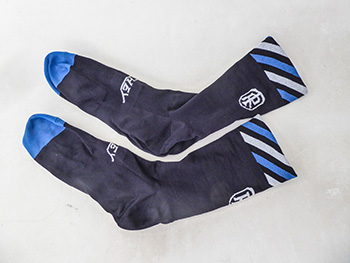
if you've had any mechanical experience with bicycles, you will probably be well aware of the in-built inconsistencies that exist. 'incompatibility' is probably a more than equitable description. this has, historically, resulted in a two-pronged attack, one prong essentially existing as the result of the other. from a purely mechanical standpoint, it makes a great deal of sense to ensure that each stage in the transmission and braking process, consists of components sourced from the same manufacturer. however, ensuring that this is the case, more often than not, plays perfectly into the hands of the marketing department.
one reinforces the other.
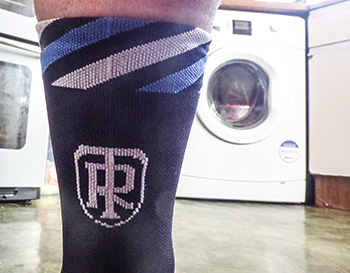
in respect of one acquaintance of mine, i have often wondered why anyone would be willing to pursue the marrying of gear levers from one purveyor, with the derailleurs of another. at some point in the process, tears are going to be the only result. the only exception to this philosophy that springs to mind, is lennard zinn, a man seemingly obsessed with exploring the compatibility between various components from various sources. in mitigation, it appears this obsession may be closely related to the number of enquiries he receives from readers intent on doing the wrong thing, as advised above.
such incompatibilities, however, seem to exist even within the same atelier. with the introduction of twelve-speed to campagnolo chorus, came a 34 tooth sprocket on the cassette. however, owners of record or super-record need not apply, as apparently the record-based rear mech is not capable of coping with so many teeth.

yet, the matching of componentry from front to rear has become the ultimate desire of many a manufacturer. the days when we would source bars, stem and seatpost based on likes or dislikes, has seemingly faded into obscurity. the modern-day implication is that matching handlebar and stem from differing sources is a travesty comparable to hanging on to the 'sticky-bottle' for more than the uci determined period of time.
my ritchey logic frameset is decorated with the aforementioned campagnolo record, twelve-speed groupset (with a compatible 32 large sprocket), matched to a pair of campagnolo bora wto 33mm carbon wheels. the ergomax bars and chicane stem are both from ritchey, the forks turning on a ritchey wcs integrated headset. the wcs seatpost also bears a ritchey logo, and pedalling duties are achieved on a pair of wcs echelon carbon pedals. the marketing departments of campagnolo and ritchey must love me.
however, if we're happy to accept the premise that componentry designed to work happily together is the ideal option when it comes to specifying a bicycle's constitution, (and i am), then it doesn't seem to stretch credibiity too far, to introduce a clothing component. however, lest i come across as a ritchey or campagnolo fan boy, i have started small with a view to potential expansion at a later date. thus, to act as mediator between my rapha shoes and ritchey echelon pedals, i have taken to wearing a pair of official ritchey cycling socks. currently retailing at the reduced price of €10.95 (£9.80), these would seem an economic start to exploring the intricacies of compatibility.

all was going swimmingly on the sunday morning ride, until we reached the hill at the rspb's aoradh farm, where my colleagues seemed to have far less difficulty ascending than did i. this led me to believe that ritchey may have sent me the sprint version of their socks, explaining their obvious incompatibility with grimpeurship. it's a situation with which i had made myself at ease, until one of the aforementioned colleagues noticed that the rear-facing ritchey logo on one sock had not been sitting straight, and thus upset my climbing feng shui (or mojo, if you prefer).
unfortunately, at the time of pointing this out, there was no opportunity to straighten the sock and blast up the nearest incline. but next week... thoroughly recommended to all ritchey and would-be ritchey owners. just be sure that you put them on straight.
next step is a ritchey cycling cap.
tuesday 8 september 2020
 ..........................................................................................................................................................................................................
..........................................................................................................................................................................................................